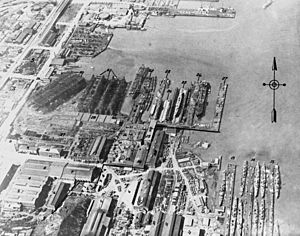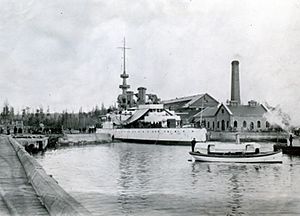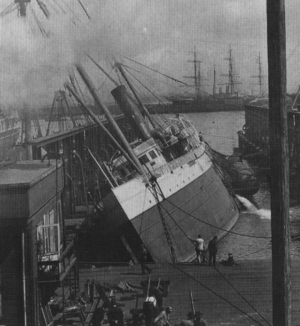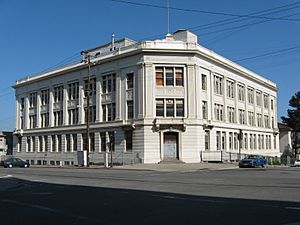Union Iron Works facts for kids
The Union Iron Works was a very important company located in San Francisco, California. It was a big part of the industrial area called Potrero Point for about 40 years, from the late 1800s to the early 1900s. This company was famous for building many things, especially ships!
History of Union Iron Works
The company started in 1849 as Union Brass & Iron Works. It was founded by Peter Donohue, who came from Ireland. His son, James Donohue, later took over the business. For many years, Union Iron Works was the top company in California for making machinery for mining, railroads, and farms.
Later, the company, led by I. M. Scott, started building ships. They moved to Potrero Point, where their shipyards are still located today. This makes it the longest-running privately owned shipyard in the United States! In 1905, another big company called Bethlehem Shipbuilding Corporation bought Union Iron Works. This new, larger company also included shipyards in Alameda and Hunter's Point.
In 1885, Union Iron Works made history by launching the first steel-hulled ship on the West Coast. It was called Arago. The steel for this ship came from another local company, Pacific Rolling Mills. A year later, in 1886, the company won a huge contract worth $1,000,000 to build a warship called USS Charleston for the United States Navy. They finished it in just 18 months!
Between 1884 and 1902, Union Iron Works built 75 different ships. This included two very famous ships from the Spanish–American War: USS Olympia and USS Oregon.
By 1892, the shipyard was a busy place, employing between 1,200 and 1,500 people. They made between $2,000,000 and $4,000,000 each year! By 1900, the shipyard had grown even bigger, and the number of workers more than doubled to 3,500. These factories used five different types of power: electricity, compressed air, steam, hydraulic power, and coal or gas fires.
Union Iron Works built many ships for the United States Navy. This included the USS Oregon, which was started in 1891. They also built the first submarines on the West Coast, Adder-class submarines Grampus and Pike, which were launched in 1902 and 1903.
In 1902, Union Iron Works became part of a larger group of companies called the United States Shipbuilding Company. This led to three years of legal problems. Then, in 1905, the entire 40-acre shipyard was bought by Bethlehem Shipbuilding Corporation for one million dollars. Charles M. Schwab, a very important businessman, bought the company.
When the big 1906 San Francisco earthquake happened, a passenger ship called Columbia was being repaired at the shipyard's drydock. The earthquake caused the Columbia to fall off its supports and roll onto its side. This badly damaged the drydock, which was a very important part of the shipyard. The Columbia itself was also damaged but was repaired and back in service by January 1907.
In 1908, Bethlehem Shipbuilding Corporation bought the Hunter's Point drydocks. Before World War I, Union Iron Works built several navy ships that became famous during the Spanish–American War, like Commodore Dewey's flagship, the Olympia. After 1905, the shipyard worked as part of Bethlehem Steel, building both warships and merchant ships.
The shipyard grew even more in 1911 when it bought Risdon Iron Works, which was right next door. Risdon Iron Works used to build locomotives (train engines). This part of the business was closed, and a new shipyard was built to make US Navy ships, including destroyers and submarines. Risdon Iron Works was founded by John Risdon in 1896. They started by building boilers, iron pipes, steam engines, and gas engines. From 1873 to 1909, Risdon Iron Works also built ships, tugs, ferries, and barges. John Risdon even held patents for the first river mining dredges.
During World War II, the shipyard was very busy! It built many different types of ships, including C1-B cargo ships, Atlanta-class cruisers, Benson-class destroyers, Buckley-class destroyer escorts, Allen M. Sumner-class destroyers, and Fletcher-class destroyers.
Locomotives Built
Union Iron Works also built many locomotives (train engines). Some of them were named after places or important people:
- "California" for the San Francisco and San Jose Railroad
- "Atlantic" for the San Francisco and San Jose Railroad
- "A. A. Sargent" for the Central Pacific Railroad
- "Mt. Diablo" for the Pittsburg Railroad
- "Boston" for the Pittsburg Railroad
- "Union" for the San Francisco and San Jose Railroad
- "Sampson" for the Pittsburg Railroad
- "D. O. Mills" (named after Darius Ogden Mills) for the Black Diamond Coal Mining Railroad
- "Calistoga" for the California Pacific Railroad
- "Lyon" for the Virginia and Truckee Railroad
- "Ormsby" for the Virginia and Truckee Railroad
- "Storey" for the Virginia and Truckee Railroad
- "J. G. Downey" (named for John G. Downey, a former Governor of California) for the San Francisco and North Pacific Railroad
- "W. C. Ralston" (named for William Chapman Ralston) for the San Francisco and North Pacific Railroad
- "Geyser" for the San Francisco and North Pacific Railroad
- "Santa Rosa" for the San Francisco and North Pacific Railroad
- "John D. Hall" for the Battle Mountain and Lewis Railroad
- "S. H. Harmon" for the Gualala Railroad
- "Starr Grove" for the Battle Mountain and Lewis Railroad
- "F. Camacho" for the Acajutla and Sonsonate Railroad
- "Ukiah" for the San Francisco and North Pacific Railroad
Ships Built
Here are some of the many ships and ferries built by Union Iron Works:
- El Primero launched in 1893
- USS Oregon launched in 1893
- USS Wisconsin launched in 1898
- Berkeley, a ferry for the Southern Pacific Transportation Company, built in 1898. This was the first complete ferry built by Union Iron Works.
- San Pablo, a passenger ferry for the Atchison, Topeka and Santa Fe Railway, built in 1899.
- Tamalpais, a passenger ferry for the Northwest Railroad, built in 1900.
- USS Ohio launched in 1901
- USS Monterey launched in 1891
- USS Wyoming launched in 1900
- USS Wheeling launched in 1897
- USS Marietta launched in 1897
- USS Charleston launched in 1888
- USS San Francisco launched 26 October 1889
- USS Olympia launched in 1892. This was Admiral Dewey's main ship during the Battle of Manila Bay.
- USS Tacoma, a Denver-class cruiser, launched in 1903
- USS Milwaukee, a St. Louis-class cruiser, launched in 1904
- Japanese cruiser Chitose launched in 1898
- Adder-class submarines USS Grampus and USS Pike for the United States Navy in 1902 and 1903
- San Pedro, a passenger ferry for the Atchison, Topeka and Santa Fe Railway, built in 1910.
- Napa Valley, a passenger ferry for Monticello Steamship Company, built in 1910.
- Tanker SS Acme for the United States Shipping Board in 1916
- Bainbridge-class destroyers USS Paul Jones, USS Perry and USS Preble for the United States Navy between 1900 and 1902
- SS Fred W. Weller, a steel tanker
- SS La Brea, a 1916 steam tanker built for Union Oil of California. It was sunk by a German submarine U-48 (1939) in 1940 during World War II.
- SS Invincible, a 1918 freighter
- SS Courageous, a 1918 steel cargo vessel
- 28 Wickes-class destroyers for the United States Navy between 1917 and 1919
- 39 Clemson-class destroyers for the United States Navy between 1918 and 1921
- San Mateo, a 1921 auto ferry.
- SS Victorious, a 1921 Steel cargo vessel
- Shasta, a 1922 auto ferry.
- Yosemite, a 1922 auto ferry.
- El Paso, a 1924 auto ferry.
- New Orleans, a 1924 auto ferry.
- Klamath, a 1924 auto ferry.
- Fresno, a 1926 auto ferry for the Southern Pacific Transportation Company.
- Stockton, a 1926 auto ferry for the Southern Pacific Railroad.
- Mendocino, a 1927 auto ferry for the Southern Pacific Railroad.
- 4 of 8 Atlanta-class cruisers: USS Oakland, USS Reno, USS Flint, and USS Tucson, for the United States Navy between 1943 and 1945
- 2 of 4 Gridley-class destroyers:
- McCall (DD-400), Maury (DD-401) for the United States Navy in 1937 and 1938
- 9 of 30 Benson-class destroyers for the United States Navy in 1941 and 1942:
- Laffey (DD-459), Woodworth (DD-460)
- Caldwell (DD-605) ... Kalk (DD-611)
- 18 of 175 Fletcher-class destroyers for the United States Navy in 1942 and 1943
- 12 of 148 Buckley-class destroyer escorts for the United States Navy in 1943 and 1944
- 6 of 58 Allen M. Sumner-class destroyers for the United States Navy in 1944 and 1945
- 3 of 98 Gearing-class destroyers:
- William C. Lawe (DD-763), Lloyd Thomas (DD-764), Keppler (DD-765) for the United States Navy in 1945 and 1946
- 5 of 95 C1-B cargo ships
Union Iron Works also helped rebuild ships. One example is:
- SS Columbia - This ship was badly damaged by the 1906 San Francisco earthquake. Union Iron Works tried to fix it, but the repairs were finished elsewhere.





